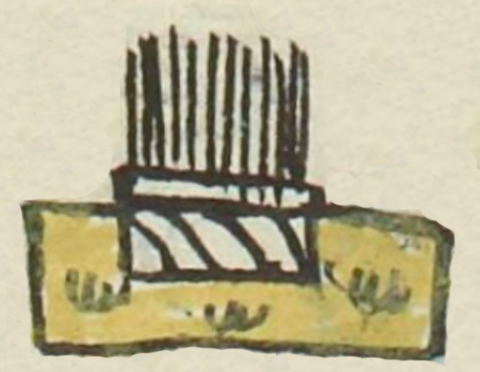Tlaltzon (MH545r)
This black-line drawing of the compound glyph for the personal name Tlaltzon (“Land Boundary,” attested here as a man’s name) shows a bird's eye view of a parcel of land (tlalli) painted yellow with three little patches of green grass. In the middle of the plot, in a frontal and elevation view, is what appears to be a box (perhaps a petlacalli), with diagonal stripes and a horizontal strip across the top. About a dozen, black, vertical, straight strands of hair (tzontli) come up out of this box.
Stephanie Wood
The hair is a phonetic indicator for the Tzon- part of the name, when in fact it probably has something to do with bringing a measurement to its limit (see the verbs tzontia and tzontlalia).
According to the Gran Diccionario Náhuatl tlaltzontli refers to boundaries o between parcels of land used by different individuals or families. It can also refer to markers (mojoneras), which is what seems to be visible in this glyph. The increasing prevalence of mojoneras goes hand in hand with colonialism and the eventual commercialization of property.
The way the land parcel is drawn shows European artistic design--very different from the parcels in the Codex Mendoza of about two decades earlier.
Stephanie Wood
Juā tlaltzon
Juan Tlaltzon
Stephanie Wood
1560
Jeff Haskett-Wood
land, tierras, parcels, parcelas, heredades, medidas, mojoneras, linderos, petacas, petlacal, petlacalli

tlaltzon(tli), land boundary or limit, https://nahuatl.wired-humanities.org/content/tlaltzontli
tlal(li), land, https://nahuatl.wired-humanities.org/content/tlalli
tzon(tli), hair or 400, https://nahuatl.wired-humanities.org/content/tzontli
tzontia, to add to the measurement, https://nahuatl.wired-humanities.org/content/tzontia
tzontlalia, to come to the limit of the measurement, https://nahuatl.wired-humanities.org/content/tzontlalia
El Lindero, o La Mojonera
Stephanie Wood
Matrícula de Huexotzinco, folio 545r, https://www.loc.gov/resource/gdcwdl.wdl_15282/?sp=169&st=image
This manuscript is hosted by the Library of Congress and the World Digital Library; used here with the Creative Commons, “Attribution-NonCommercial-ShareAlike 3.0 License” (CC-BY-NC-SAq 3.0).




